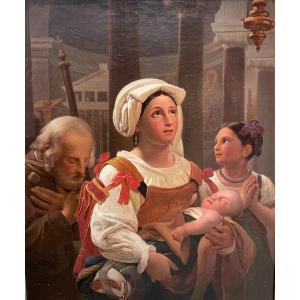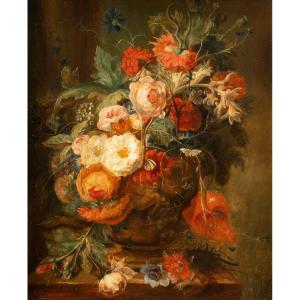Sleeping Venus.
1710-1727.
Oil on canvas.
H: 120 ; W: 97 cm.
History: Sale, The Hague, 27 February 1727, no. 14: ‘Een Slapende Venus van Terwefte zeer levendig gefchildert’.
Originally from The Hague, where he was born in 1670, Mattheus Terwesten began his career in Rome, where he worked after the great masters, before moving to Berlin for just over a year. Returning to his home town in June 1699, he was recognised as a painter of the first rank, receiving major commissions from wealthy individuals and becoming a teacher at the city's drawing academy.
He specialised in history painting, and was noted for his many monumental depictions of seated female figures with distinctive physiognomies. One of his earliest examples, an Allegory of Liberty from 1701 (Fig. 3), echoes to a great extent a work from the end of his career, an Allegory of Peace (Fig. 4) executed in 1740.
Of similar dimensions, our Sleeping Venus shares several characteristics with the latter, both in the brushwork with regard to the hair and flesh and in the representation of the face and body. The depiction also takes place in a landscape, reminiscent of other works by the artist. Flora and Zephyr (Fig. 5), which is attributed to him, probably dates from the same period as our painting, i.e. from the first or second decade of the 18th century. In addition to the similar drapery, the ground is strewn with fine, meticulously treated herbaceous plants. His later Ceres (Fig. 6) of 1738 and Venus and Adonis (Fig. 7) of 1748, despite a more refined evolution of the brushwork, also feature a similar landscape.
Our Sleeping Venus bears witness to Terwesten's regard for Correggio, whom he certainly admired during his trip to Italy. However, the artist was also inspired by the work of one of his most famous contemporaries and compatriots of the time, Willem van Mieris. The latter was active at the time in Leiden, barely ten kilometres from The Hague.
Our work is therefore close in composition to the Bacchanal (fig. 8) by Mieris, dated 1709 and in the Wallace Collection, or to a Sleeping Shepherdess (fig. 9) by the same artist, executed in 1718, as far as the motif of the sleeping woman is concerned.












































 Le Magazine de PROANTIC
Le Magazine de PROANTIC TRÉSORS Magazine
TRÉSORS Magazine Rivista Artiquariato
Rivista Artiquariato